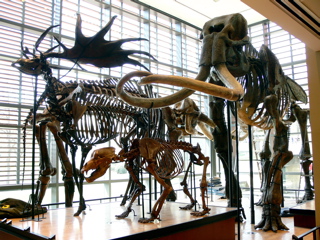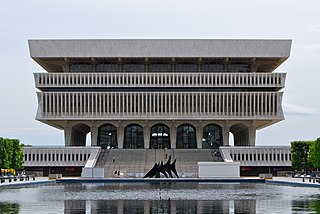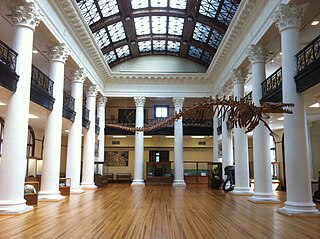
The Cleveland Museum of Natural History is a natural history museum in University Circle, a district of educational, cultural and medical institutions approximately five miles (8 km) east of Downtown Cleveland, Ohio, United States. The museum was established in 1920 by Cyrus S. Eaton to perform research, education and development of collections in the fields of anthropology, archaeology, astronomy, botany, geology, paleontology, wildlife biology, and zoology. The museum traces its roots to the Ark, formed in 1836 on Cleveland's Public Square by William Case, the Academy of Natural Science formed by William Case and Jared Potter Kirtland, and the Kirtland Society of Natural History, founded in 1869 and reinvigorated in 1922 by the trustees of the Cleveland Museum of Natural History.

The Burke Museum of Natural History and Culture is a natural history museum on the campus of the University of Washington, in Seattle, Washington, United States. It is administered by the UW College of Arts and Sciences. Established in 1899 as the Washington State Museum, the museum traces its origins to a high school naturalist club formed in 1879. The museum is the oldest in Washington state and boasts a collection of more than 16 million artifacts, including the world's largest collection of spread bird wings. The Burke Museum is the official state museum of Washington.

The Florida Museum of Natural History (FLMNH) is Florida's official state-sponsored and chartered natural history museum. Its main facilities are located at 3215 Hull Road on the campus of the University of Florida in Gainesville.

The Santa Barbara Museum of Natural History is a natural history museum in Santa Barbara, California.
The culture of Ann Arbor, Michigan includes various attractions and events, many of which are connected with the University of Michigan.

Nichols Arboretum, locally known as the Arb, is an arboretum on the campus of the University of Michigan, in Ann Arbor, Michigan. The Arb is located adjacent to the Huron River, and features over 400 species, including 110 species of trees, in a varied, hilly landscape. A signature feature of Nichols Arboretum is the W. E. Upjohn Peony Garden, which features the largest collection of heirloom peonies in North America.
The Natural History Museum of Utah is a museum located in Salt Lake City, Utah, United States. The museum shows exhibits of natural history subjects, with an emphasis on Utah and the Intermountain West. The mission of the museum is to illuminate the natural world and the place of humans within it. A new building, named the Rio Tinto Center, opened in November 2011. The museum is part of the University of Utah and is located in the university's Research Park.

The Beneski Museum of Natural History, Amherst College, is located on the campus of Amherst College in Amherst, Massachusetts. It showcases fossils and minerals collected locally and abroad, many by past and present students and professors. The museum is located in the Beneski Earth Sciences Building, completed in 2006. It is a member of Museums10.

The University of Michigan Museum of Art (UMMA) is one of the largest university art museums in the United States, located in Ann Arbor, Michigan, with 94,000 sq ft (8,700 m2). Built as a war memorial in 1909 for the university's fallen alumni from the Civil War, Alumni Memorial Hall originally housed University of Michigan's Alumni office along with the university's growing art collection. Its first director was Jean Paul Slusser, who served from 1946 to his retirement in 1957.

The New York State Museum is a research-backed institution in Albany, New York, United States. It is located on Madison Avenue, attached to the south side of the Empire State Plaza, facing onto the plaza and towards the New York State Capitol. The museum houses art, artifacts, and ecofacts that reflect New York’s cultural, natural, and geological development. Operated by the New York State Education Department's Office of Cultural Education, it is the oldest and largest state museum in the US. Formerly located in the State Education Building, the museum now occupies the first four floors of the Cultural Education Center, a ten-story, 1,500,000-square-foot (140,000 m2) building that also houses the New York State Archives and New York State Library.

The Museum of the Earth is a natural history museum located in Ithaca, New York. The museum was opened in 2003 as part of the Paleontological Research Institution (PRI), an independent organization pursuing research and education in the history of the Earth and its life. Both PRI and the Museum of the Earth are formally affiliated with Cornell University. The Museum of the Earth is home to Earth science exhibits and science-related art displays with a focus on the concurrent evolution of the Earth and life.

The University of Oregon Museum of Natural and Cultural History is a natural history museum on the University of Oregon campus, in Eugene, Oregon, United States of America. The museum headquarters and public spaces are located at 1680 East 15th Avenue in a building inspired by the design of Pacific Northwest Native longhouses.

The Alabama Museum of Natural History is the state's natural history museum, located in Smith Hall at the University of Alabama campus in Tuscaloosa. The oldest museum in the state, it was founded in 1831.
The Georgia Museum of Natural History is the U.S. state of Georgia's museum of natural history located in Athens, Georgia. The museum has eleven different collections in Anthropology, Arthropods, Botany, Geology, Herpetology, Ichthyology, Invertebrate, Mammalogy, Mycology, Ornithology, and Zooarchaeology. In addition, there are exhibitions, archives, and entertainment for children. The Exhibit Gallery is free and open to the public during scheduled hours. People can schedule a tour to visit the collections by appointment.

The University of Michigan Museum of Natural History (UMMNH) is a natural history museum of the University of Michigan in Ann Arbor, Michigan, United States.
Dibsi Faraj is an archaeological site on the right bank of the Euphrates in Aleppo Governorate (Syria). The site was excavated as part of a larger international effort coordinated by UNESCO to excavate as many archaeological sites as possible in the area that would be flooded by the reservoir created by the Tabqa Dam, which was being built at that time. An initial, small archaeological sounding was done at Dibsi Faraj by the Syrian Department of Antiquities in 1971. Following this investigation, the site was excavated between 1972 and 1974 as part of a joint operation of the Dumbarton Oaks Center for Byzantine Studies and the Kelsey Museum of Archaeology at the University of Michigan under the direction of Richard P. Harper. Since then, the site has disappeared under the rising waters of Lake Assad, the reservoir created by the Tabqa Dam.
The Sindecuse Museum of Dentistry is a museum of the history of dentistry, operated by the University of Michigan School of Dentistry in Ann Arbor, Michigan. Visitors to the museum can only gain access to the building through the main clinic entrance. Located on the university's Central Campus, the museum is one of only a handful of dentistry museums in the world.

The Kelsey Museum of Archaeology is a museum of archaeology located on the University of Michigan central campus in Ann Arbor, Michigan, in the United States. The museum is a unit of the University of Michigan's College of Literature, Science, and the Arts. It has a collection of more than 100,000 ancient and medieval artifacts from the civilizations of the Mediterranean and the Near East. In addition to displaying its permanent and special exhibitions, the museum sponsors research and fieldwork and conducts educational programs for the public and for schoolchildren. The museum also houses the University of Michigan Interdepartmental Program in Classical Art and Archaeology.















